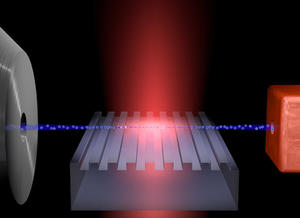DetectionCompact, high-power terahertz source at room temperature developed
Terahertz (THz) radiation — radiation in the wavelength range of 30 to 300 microns — is gaining attention due to its applications in security screening, medical and industrial imaging, agricultural inspection, astronomical research, and other areas. Traditional methods of generating terahertz radiation usually involve large and expensive instruments, some of which also require cryogenic cooling. Researchers have developed a compact, room-temperature terahertz source with an output power of 215 microwatts.

Particle physists are now using light to accelerate particle // Source: .northwestern.edu
Advance in electromagnetic wave technology could aid homeland security, medical imaging, space research, and more
Terahertz (THz) radiation — radiation in the wavelength range of 30 to 300 microns — is gaining attention due to its applications in security screening, medical and industrial imaging, agricultural inspection, astronomical research, and other areas. Traditional methods of generating terahertz radiation, however, usually involve large and expensive instruments, some of which also require cryogenic cooling. A compact terahertz source — similar to the laser diode found in a DVD player — operating at room temperature with high power has been a dream device in the terahertz community for decades.
A Northwestern University release reports that Manijeh Razeghi, Walter P. Murphy Professor of Electrical Engineering and Computer Science at Northwestern University’s McCormick School of Engineering and Applied Science, and her group has brought this dream device closer to reality by developing a compact, room-temperature terahertz source with an output power of 215 microwatts.
Razeghi presented the research on 7 October at the International Conference and Exhibition on Lasers, Optics & Photonics in San Antonio, Texas, and also at the European Cooperation in Science and Technology conference in Sheffield, England on 10 October. The findings were published 1 July in the journal Applied Physics Letters, and were presented at the SPIE Optics + Photonics conference in August in San Diego.
Razeghi’s group is a world leader in developing quantum cascade lasers (QCL), compact semiconductor lasers typically emitting in the mid-infrared spectrum (wavelength range of 3 to 16 microns).
Terahertz radiation is generated through nonlinear mixing of two mid-infrared wavelengths at 9.3 microns and 10.4 microns inside a single quantum cascade laser. By stacking two different QCL emitters in a single laser, the researchers created a monolithic nonlinear mixer to convert the mid-infrared signals into terahertz radiation, using a process called difference frequency generation. The size is similar to standard laser diode, and a wide spectral range has already been demonstrated (1 to 4.6 THz).
“Using a room-temperature mid-infrared laser to generate terahertz light bypasses the temperature barrier, and all we need to do is to make the output power high enough for practical applications,” said Razeghi, who leads Northwestern’s Center for Quantum Devices (CQD). “Most applications require a minimum of microwatt power levels, but, of course, the higher the better.”
The achieved output power, 215 microwatts, is more than three times higher than earlier demonstrations. This dramatic boost is due to a number of novelties, including Cherenkov phase matching, epilayer down mounting, symmetric current injection, and anti-reflection coating.
The release notes that the researchers will now work to achieve continuous wave operation and incorporate tuning in the device.
The work is supported by National Science Foundation (NSF) and National Aeronautics Space Association (NASA).
— Read more in Chu-Young Cho et al., “Surface plasmon enhanced light emission from AlGaN-based ultraviolet light-emitting diodes grown on Si (111),” Applied Physics Letters 102 (31 May 2013): 211110 (doi: org/10.1063/1.4809521)
